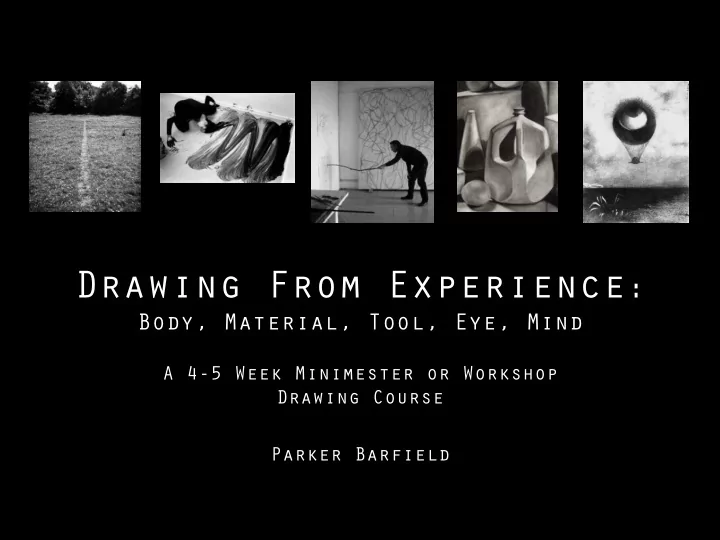

Drawing From Experience : Body, Material, Tool, Eye, Mind A 4-5 Week Minimester or Workshop Drawing Course Parker Barfield
Research Question • Art Question: Art Question: How does art serve as experience: viewing/making As a primary experience or is art a symbolized secondary experience? • Art Education Question: Art Education Question: Is there an inclusive curriculum that can allow students to investigate and communicate both primary and secondary experiences
Background • What is Experience? – Primary (sensation) vs. Secondary (reflection) à Interdependent – Knowing something happened vs. Understanding what it means Woman In front of Setting Sun , Caspar David Friedrich, 1820
John Dewey’s Art as Experience (1934) “What is called the magic of the artist resides in his ability to transfer these values from one field of experience to another, to attach them to the objects of our common life and by imaginative insight make these objects poignant and momentous.” (1934, 118)
4-5 Week Drawing Workshop • Objective: Through the medium of drawing, students Objective: will explore both primary and secondary experiences while creating drawings that emphasize: body, materials, tools, eye, and mind • Outcomes – Students better understand their own Primary and Secondary experiences and how this can be a driver for their art – Students engage and explore Their Self Holistically: body, Material, Tool, Eye, and Mind – Students explore a wide variety of techniques and methodologies for creating drawings – Students find their own voice and can fully express their experience through drawing
Unit 1: Body • Objective: To understand/explore primary, Highly Sensory experience by using “the body without tools” to produce a drawing in a natural setting • Warm up Exercises: Try to detect different temperatures while walking barefoot, walk along a wall with closed eyes trying to feel the differences between sun and shade, recording sounds, touching surfaces, feeling how the body responds to light and dark and registering movements in the environment, such as the wind in the bushes and over the earth.
Unit 1:Examples Richard Long, Richard Long, A Line Made by Waterlines , 2003 Walking , 1967 Andy Goldsworthy, Rain Shadow, 1984 Janine Antoni, Loving Care, 1993
Unit 2: Material • Objective: You will undergo a series of non representational drawing exercises using various “non drawing” and drawing materials applied without the use of tools • Possible Exercises and Activities: – Make 500 marks counting out loud with your eyes closed – In 2 minutes while wearing a blind fold make 200 vertical lines in the center of the page in the shape of a square – Draw using an extremely difficult part of the body dipped in materiel i.e, the nose, ear, stomach – Vary the Velocity and gesture of the mark – Use a stencil and fill in with material, make a pattern – Take one of your shorter exercises and begin to develop it into a final drawing over an extended period of time – edit it for aesthetic merit, unity, and compositional structure
Unit 2: Examples Richard Long, Mud Work Richard Long, Southern Richard Long, Mud Gravity, 2011 Drawing, 2013 Janine Antoni Richard Serra, Throwing Robert Morris molten lead, 1968
Unit 3: Tool • Objective: You will be taken through a series of exercises using non traditional drawing tools, learn to exploit the capabilities and limitations of drawing tools • Possible Exercises – Create a series of horizontal lines walking the length of a long horizontal piece of paper using both dominant and non dominant hand – In 3 minutes create a series of 6’’ horizontal lines down the center of the page with ⅛ ’’ separation between – Vary the pressure and velocity while using the tool – Play exquisite corpse with mark making, or make a few marks and then pass among classmates – Work together collaboratively using selected materials to create a larger composition from scratch or develop further some of the drawings from earlier exercises
Unit 3: Examples ART 112 2D Design
Unit 4: Eye • Objective: developing perceptual and descriptive connection between the hand and the eye. learning to draw what you see, (Knowing vs. Seeing and Drawing Symbols vs. Looking). • Exercises: – One and Two Point Perspective Exercises – Blind Contour and Contour Exercises – Gesture Exercises – Modeling and value exercises – Final Task: Long duration still life drawing
Unit 4: Examples Two Point Perspective Studies Blind Contour Studies Cross Contour Studies Value and Texture studies Still Life Gesture Drawings Drawing
Unit 5: Mind • Objective: Represent experience using metaphor or symbolic representation. To create imaginative or fantastical artwork that represents your experience as taking place in an imaginative world. • To understand the rich possibilities of expresses your experience through metaphor and imagination, does the experience become richer? • ossible Projects: • Develop a Personal Metaphor, Create a Synectic Drawing, Represent your experience in a fantasy World Drawing, draw your experience in dream project
Unit 5: Examples Tomoko Konoike, Mimio Odyssey, 2005, Kawasawa Hitoshi, Voyage, 1986-90 Odilon Redon, The Eye Like Strange Balloon Salvador Rene Magritte, Mounts Towards Infinity, Dali, Untitled, 1963 1882 Illustration
Possible Final • Create a piece that combines several primary and secondary ways of working and drawing
Conclusion • Students investigated various ways art acts as experience while moving fluidly between primary and secondary experience and reflection. • Students increased range of techniques, formal skills, and methodologies • Students developed a holistic drawing practice: Body, Material, Tool, Eye, and Mind
Recommend
More recommend